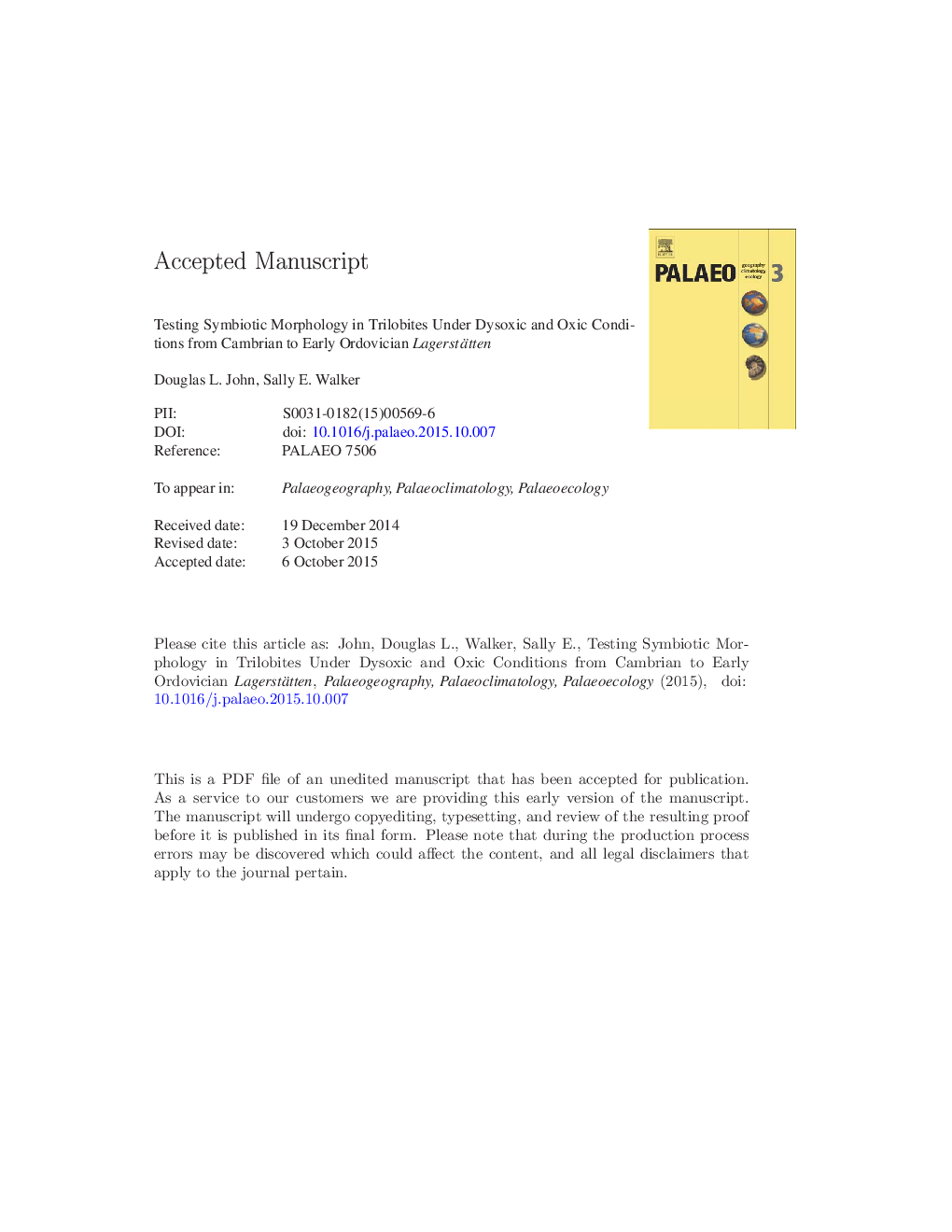| کد مقاله | کد نشریه | سال انتشار | مقاله انگلیسی | نسخه تمام متن |
|---|---|---|---|---|
| 6349313 | 1313955 | 2016 | 76 صفحه PDF | دانلود رایگان |
عنوان انگلیسی مقاله ISI
Testing symbiotic morphology in trilobites under dysoxic and oxic conditions from Cambrian to Early Ordovician Lagerstätten
دانلود مقاله + سفارش ترجمه
دانلود مقاله ISI انگلیسی
رایگان برای ایرانیان
کلمات کلیدی
موضوعات مرتبط
مهندسی و علوم پایه
علوم زمین و سیارات
فرآیندهای سطح زمین
پیش نمایش صفحه اول مقاله

چکیده انگلیسی
Dysoxic conditions were prevalent in Cambrian and Early Ordovician oceans. Adaptations of trilobites to these conditions yield insight into the selective forces driving their evolution and the potential for modern arthropods to adapt to anthropogenically-driven dysoxia. In the early Paleozoic, olenid trilobites may have adapted to dysoxia through olenimorphy, special morphologic adaptations facilitating symbiosis with sulfur-oxidizing bacteria. Olenimorphy's link to symbiosis has never been tested and might instead be related to phylogeny. Here, we tested whether olenimorphy occurs predominately in dysoxic environments, as expected, or whether it occurs within certain trilobite groups regardless of environment. Trilobites were selected from nine fossil Lagerstätten representing the early-to-middle Cambrian prior to olenid evolution and the middle Cambrian-Early Ordovician Alum Shale with olenids, putative exemplars of symbiosis. Trilobite morphology was scored as ranked characters and reduced via non-metric multidimensional scaling (NMDS) to a single metric describing suitability for symbiosis. Results indicated that olenimorphy was significantly related to phylogeny and not environment. In the early-to-middle Cambrian, dysoxic corynexochids and oxic redlichiids were equally unsuitable for symbiosis, while ptychopariids from both oxic and dysoxic conditions were equally well suited for symbiosis. In the Alum Shale, asaphids and ptychopariids from both oxic and dysoxic conditions were equally well suited for symbiosis, and redlichiids from oxic conditions were poorly suited. Olenids were not the best-suited trilobites within their data set, nor even within their order. Secular trends in thoracic segmentation did not bias our results. Trilobite hard parts do not appear to provide evidence for symbiosis, which is consistent with modern arthropods that have few morphological adaptations for dysoxic conditions. In fact, arthropods are rare in persistently dysoxic conditions, raising concerns about the spread of anthropogenically-triggered benthic dysoxia in the future, particularly given the extinction of trilobites under similar conditions at the end of the Permian.
ناشر
Database: Elsevier - ScienceDirect (ساینس دایرکت)
Journal: Palaeogeography, Palaeoclimatology, Palaeoecology - Volume 441, Part 4, 1 January 2016, Pages 704-720
Journal: Palaeogeography, Palaeoclimatology, Palaeoecology - Volume 441, Part 4, 1 January 2016, Pages 704-720
نویسندگان
Douglas L. John, Sally E. Walker,